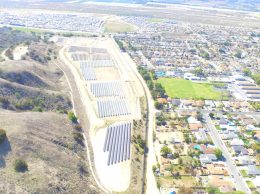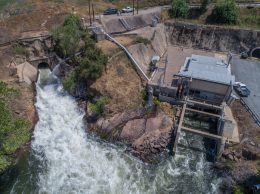
The Drumheller Rice Dryers farming operation powered by Solar3D in Butte City, California. (Photo courtesy of Solar3D)
Although the sun seems to have set on the Tri-Counties’ once-burgeoning solar technology industry, Santa Barbara-based Solar3D is using its R&D roots to launch a green energy empire.
Most of the region’s solar firms shifted their business models from development to installation services once China clenched a solar manufacturing monopoly thanks to its cheap production costs. But Solar3D, which has been on the South Coast since 2002, leveraged a series of strategic acquisitions into an up-listing onto the NASDAQ that netted the firm $12.5 million.
As the Business Times went to press Wednesday, Solar3D stock — trading under the marker SLTD — closed at $5.01 a share, up from its $3.10 close on March 4, its first day on the NASDAQ.
Solar3D may be the last of a dying breed. In February, publicly traded Duke Energy acquired a majority stake in the region’s largest remaining solar installation firm, REC Solar, based in San Luis Obispo.
Notable development projects in the area are back by outside firms, such as the record-setting New Cuyama and Topaz solar farms built by Tempe-based First Solar. And incidents like the Chinese government hack of SolarWorld’s networks at the firm’s Camarillo office compromised proprietary information, crippling its production prowess.
But Solar3D is thriving. The firm raked in $20.2 million in revenue for 2014 and reported operating income of $311,072, compared to an operating loss of $1.1 million for the same period in 2013.
When CEO Jim Nelson joined Solar3D five years ago, leaving a 25-year career in private equity for the opportunity to work in Santa Barbara, the firm was just a small development. The technology never really took off, Nelson said, and he set to diversify the business to capitalize on opportunities in the burgeoning green energy sector.
“The solar industry is going to be the fastest-growing business in the world in 20 years,” Nelson said. “People on Wall Street believe that, people in federal government believe that — it’s just going to boom.”
The company has installed more than 450 commercial and residential systems since 2013, but it gets a leg up on install-only from competitors by offering what it calls integration services — starting from the time someone is interested in having a test done, to monitoring the system and overseeing maintenance.
“You do everything in between,” Nelson said. “In fact, in integration you do everything in the solar business, with the exception of manufacturing the part.”
But the company hasn’t stopped investing in technology development and is working with UC Santa Barbara scientists to build a new solar cell that is more powerful than incumbent technology. Nelson also has close ties to John Bowers and Dave Auston, leaders of the university’s Institute for Energy Efficiency, and has a 30-year relationship with Jeff Henley, the Oracle executive who donated $50 million to the institute.
According to Nelson, such R&D operations are what put Solar3D on the map, and it still has plans to commercialize its technology. “We hope to be able to commercialize it this year,” he said. “And we got some attention because of the fact that we’re working with UCSB and have been able to develop this technology, and that allowed us to then acquire these companies that have really helped us.”
Solar3D’s bread and butter has come to be expanding business through acquisitions. Since American companies can no longer viably compete with Asian ones in solar manufacturing, Nelson said his belief is that “if you really want to make a competitive company, you have to do it as fast as you can. So there’s no shame, if you’re a smart business guy and you love America, in partnering with other companies and other countries that do things well.”
So Nelson went shopping for companies that do solar integration. After its first purchase, a company in Roseville called SUNworks, Solar3D “boomed,” Nelson said, and SUNworks nearly tripled its sales in 2014, the first year after the sale.
On March 2, the firm closed another deal with MD Energy in Rancho Cucamonga, giving it a presence in the north and south of the state and the leverage to go from over-the-counter trading up to the NASDAQ.
Solar3D is positioning itself to have resources present in the field rather than concentrated in one location. Though it has 90 employees overall, only four work out of its Santa Barbara headquarters.
“There are 35 million people in California and less than 1 percent of them are here in greater Santa Barbara. People who come here and bet everything on Santa Barbara are bound to lose — there’s just not a critical mass,” Nelson said. “Our company has a statewide reach, so that fact that we are headquartered in a smaller market doesn’t affect that.”
The $12.5 million the up-listing brought in will help Solar3D shape up its balance sheet and fund additional acquisitions, Nelson said. And just being on the NASDAQ gives the firm increased equity for transactions as well as an expanded and solidified investor base.
“As an OTC company we just had a bunch of retail — which is individual — investors,” Nelson said. “It allows us to bring in institutions and do other things that will add to strength and stability of our investor base.”
Next, Nelson said the company is looking to acquire a couple more companies this year and two or three next year, targeting firms with between $10 million and $50 million in revenue located in California and Nevada, which account for well over half of U.S. installations.






 Print
Print Email
Email

















